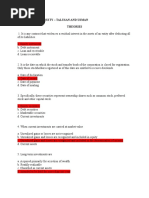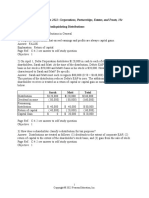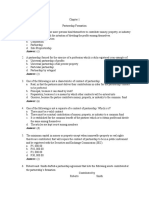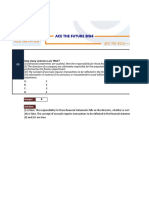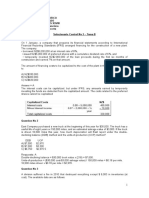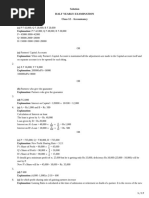ACCA 305 Extra Credit Assignment
Uploaded by
Cooper89ACCA 305 Extra Credit Assignment
Uploaded by
Cooper89INTERMEDIATE FINANCIAL ACCOUNTING II
2014
Extra Credit
Assignment
Tuesday, 04 March
Aleshia Cooper
Mr. Terrance Richards
A. Cooper 2
Multiply Choice Section
1. Answer: b. The par value of all capital stock issued.
Explanation: Legal Capital is the par value of all of a company's shares outstanding. Legal
capital may not be distributed as dividends, or as anything else. It is also called stated capital.
2. Answer: c. Bear the ultimate risks and uncertainties and receive the benefits of enterprise
ownership.
Explanation: Common stockholders are the residual owners of a corporation in that they have a
claim to what remains after every other party has been paid. The value of their claim depends on
the success of the firm. When you own common stock, your shares represent ownership in the
corporation and give you the right to vote for the company's board of directors and benefit from
its financial success.
3. Answer: c. A claim against a portion of the total assets of an enterprise.
Explanation: Stockholders' equity represents the equity stake currently held on the books by a
firm's equity investors .It is calculated either as a firm's total assets minus its total liabilities, or as
share capital plus retained earnings minus treasury shares.
4. Answer: c.May decrease but not increase retained earnings.
Explanation:
5. Answer: c.Redeemable
Explanation:
6. Answer: c.means that the shareholder can accumulate preferred stock until it is equal to the par
value of common stock at which time it can be converted into common stock.
Explanation:
7. Answer: c. Decrease No effect
Explanation:
A. Cooper 3
8. Answer: b.Liquidation preferences
Explanation:
9. Answer: c.Treasury Stock for $60,000 and Paid-in Capital from Treasury Stock for $16,000.
Explanation: 4,000 * $15 = $60,000 4,000 * $4 = $16,000.
10. Answer: c.$905,000
Explanation: 900,000 + 2,000 * 5 500 * 10 = $ 905,000
11. Answer: d.$3,330,000.
Explanation: 675,000 * 4 + 90,000 * 7 = $3,330,000
12. Answer: c.$ 7,000
Explanation: 2,000 * 50 * .06 = $6,000 ($6,000 $5,000) + $6,000 = $7,000
13. Answer: a.$15,000
Explanation: 5,000 * 100 * .05 = $25,000 (45,000 * 2) (25,000 * 3) = $15,000
14. Answer: a.reflected currently in income, but not as an extraordinary item.
Explanation:
15. Answer: d.treated as a direct reduction of retained earnings.
Explanation:
16. Answer: b.book value method.
Explanation:
17. Answer: d.based on the relative market values of the two securities involved.
A. Cooper 4
Explanation:
18. Answer: c. No Yes
Explanation:
19. Answer: b.the holder has to pay a certain amount of cash to obtain the shares.
Explanation:
20. Answer: a.credit of $136,000 to Paid-in Capital in Excess of Par
Explanation: $800,000 + 175,000 * .32 800 * 30 * 30 = $136,000.
21. Answer: b.$3,600 increase in paid-in capital in excess of par.
Explanation: 60,000 (1,200 45) 2,400 = $3,600
22. Answer: a. $330,000
Explanation: (2,400,000 1,000) * 40 * 20 = $1,920,000
(2,400,000 16,000,000) * 1,000,000 = $150,000
2,400,000 1,920,000 150,000 = $330,000.
23. Answer: c. $70,500.
Explanation: (3,000,000 2,883,000) 117 = $1,000
A. Cooper 5
(3,000,000 .09 3/12) + (1,000 3) = $70,500.
24. Answer: b.$21,600.
Explanation: $117,000 117 = $1,000
$117,000 (1,000 * 3) + (1,000 * 6) * $600,000/$3,000,000= $21,600
25. Answer: b. Cash 240,000
Paid-in CapitalStock Warrants 40,000
Common Stock 160,000
Paid-in Capital in Excess of Par 120,000
Explanation: Cash: 16,000 * 15 = $240,000
Paid-in CapitalStock Warrants: $100,000 * 16/40 = $40,000
Common Stock: 16,000* 10 = $160,000
Paid-in Capital in Excess of Par: 240,000+40,000-160,000= $120,000.
26. Answer b.$20,500
Explanation: 20,000 (20,000 + 180,000) * $205,000 = $20,500.
27. Answer: c.discount of $5,600.
Explanation: 500,000 * .96 + 500 * 20 * $2 = $500,000
500,000 494,400 = $5,600
A. Cooper 6
28. Answer: b. warrants.
Explanation: Securities which could be classified as held-to-maturity are warrants
29. Answer: c.trading.
Explanation: Unrealized holding gains or losses which are recognized in income are from
securities classified as trading.
30. Answer: a. make an adjusting entry to debit Interest Receivable and to credit Interest Revenue
for the amount of interest accrued since the last interest receipt date.
Explanation: The investor must make an adjusting entry to debit Interest Receivable and to
credit Interest Revenue for the amount of interest accrued since the last interest receipt date.
31. Answer: a. held-to-maturity debt securities.
Explanation: Debt securities that are accounted for at amortized cost, not fair value, are held-to-
maturity debt securities.
32. Answer: c. available-for-sale debt securities.
Explanation: Debt securities acquired by a corporation which are accounted for by recognizing
unrealized holding gains or losses and are included as other comprehensive income and as a
separate component of stockholders' equity are
33. Answer: b.a varying amount being recorded as interest income from period to period.
Explanation: Use of the effective-interest method in amortizing bond premiums and discounts
results in a varying amount being recorded as interest income from period to period.
34. Answer: a.available-for-sale securities where a company has holdings of less than 20%.
A. Cooper 7
Explanation: Equity securities acquired by corporations which are accounted for by recognizing
unrealized holding gains or losses as other comprehensive income and as a separate component
of stockholders' equity are available-for-sale securities where a company has holdings of less
than 20%.
35. Answer: d.All of these are required
Explanation: A requirement for a security to be classified as held-to-maturity is ability to hold the
security to maturity, positive intent and the security must be a debt security
36. Answer: b.acquisition cost plus amortization of a discount.
Explanation: Held-to-maturity securities are reported at acquisition cost plus amortization of a
discount.
37. Answer: c. a debit to Held-to-Maturity Securities at $315,000.
Explanation:
38. Answer: d. All of these are correct.
Explanation: In regard to trading securities they are held with the intention of selling them in a short
period of time. Unrealized holding gains and losses are reported as part of net income. Any
discount or premium is not amortized.
39. Answer: c . any discount or premium is not amortized
Explanation:
40. Answer: c. Available-for-Sale Securities 194,000
Interest Revenue 4,500
Cash 198,500
A. Cooper 8
Explanation:
41. Answer: b.$414,000
Explanation: ($400,000 * 1.02) + $6,000 = $414,000.
42. Answer: d.$686.
Explanation: ($376,100 * .055) ($400,000 * .05) = $686
43. Answer: b.$41,409.
Explanation: $376,100 * .055 = $20,686 ($376,100 + $686) * .055 - $20,723;
$20,686 + $20,723 = $41,409.
44. Answer: b. $20,000 loss
Explanation: $400,000 $380,000 = $20,000 loss.
45. Answer: c. $20,000 gain
Explanation: 320,000 $300,000 = $20,000 gain.
46. Answer: b. Securities Fair Value Adjustment 5,000
(Available-for-Sale)
Unrealized Holding Gain or Loss-Equity 5,000
A. Cooper 9
Explanation: ($40,000 $33,000) $2,000 = $5,000
47. Answer: b.$260,000
Explanation: + [($420,000 $180,000) .25] = $320,000 X + $60,000 =
$320,000 X = $260,000.
48. Answer: c. $50,000
Explanation: 200,000 * (25,000 100,000) = $50,000
49. Answer: c. $564,000
Explanation: $500,000 + [($800,000 $640,000) * (20,000 50,000)] = $564,000.
50. Answer: a.$320,000.
Explanation: $800,000 (20,000 50,000) = $320,000.
51. Answer: c. $195,000
Explanation: acquisition cost
52. Answer: b.$225,000
Explanation: acquisition cost
53. Answer: b.$135,000
Explanation: acquisition cost
54. Answer: b.$216,000
55. Explanation: $202,500 + ($75,000 * .3) ($30,000 *.3) = $216,000
A. Cooper 10
Problems Section
Problem 1.
(a) As of 12/31/11, it is desired to distribute $250,000 in dividends. How much will the preferred
stockholders receive if their stock is cumulative and nonparticipating?
Answer: ($400,000 * .06 * 3) = $72,000
(b) As of 12/31/11, it is desired to distribute $400,000 in dividends. How much will the preferred
stockholders receive if their stock is cumulative and participating up to 11% in total?
Answer: 72,000 + [(.11 -.06) =.05 * 400,000] =$92,000
(c) On 12/31/11, the preferred stockholders received a $120,000 dividend on their stock which is
cumulative and fully participating. How much money was distributed in total for dividends
during 2011?
Answer: $1,600,000 x .06 + [($120,000 - $72,000) $400,000)] x $1,600,000 =576,000-288,000 +
120,000=$ 408,000
A. Cooper 11
Problem 2.
Instructions
Prepare the general journal entries necessary to record these transactions.
ACCOUNT Debit Credit
No entry
No entry
Land 300,000
Common Stock 40,000
A.P.I.C 260,000
Cash 600,000
Preferred Stock 500,000
A.P.I.C 100,000
Organization Expense 6,000
Common Stock 500
A.P.I.C
5,500
A. Cooper 12
Problem 3.
The original sale of the $50 par value common shares of Gray Company was recorded as
follows:
Cash 290,000
Common Stock 250,000
Paid-in Capital in Excess of Par 40,000
ACCOUNT Debit Credit
Treasury Stock 18,600
Cash 18,600
Cash 4,800
Retained Earnings 160
Treasury Stock
4,960
Cash 2,720
Paid-in Capital from
Treasury Stock
240
Treasury Stock 2,480
A. Cooper 13
Problem 4.
Instructions
Compute the weighted average number of shares to be used in computing earnings per
share for 2010
Date Increase/Decrease Outstanding
shares
Months
Outstanding
Stock Split Share
Months
Jan. 1 1,000,000 2/12 2/1 333,333.3333
March 1 150,000 1,150,000 4/12 2/1 766,666.6666
July 1 1,150,000 2,300,000 3/12 575,000
Oct. 1 (600,000) 1,700,000 3/12 425,000
Weighted
Average
2,100,000
Problem 5.
A. Cooper 14
What accounting treatment is required for convertible debt? Why? What
accounting treatment is required for debt issued with stock warrants? Why?
Convertible debt is treated only as debt. Firstly, as convertible bonds usually carried
lower interest rate than ordinary debt because of the conversion option, the true opportunity cost
of financing the debt was not being recognized. Secondly, the financial position of the entity did
not present the fact that the entity had in effect issued share options as part of the convertible
debt arrangement. Upon maturity of the convertible bonds, the accounting treatment depends on
whether the conversion option is exercised or lapsed. If the conversion option is not exercised,
the company will have to pay the principal amount of the convertible bonds. Therefore, the
outstanding liability may be simply de-recognized. If however, the conversion option is
exercised, the company will have to issue shares to the bondholders. Hence, both liability and
equity components of the convertible bonds will need to be de-recognized and replaced by share
capital reserves as they are treated as consideration for the new shares issue.
When debt is issued with stock warrants, the warrants are given separate recognition.
After issue, the debt and the detachable warrants trade separately. The proceeds may be allocated
to the two elements based on the relative fair values of the debt security without the warrants and
the warrants at the time of issuance.
Problem 6
A. Cooper 15
For each of the unrelated transactions described below, present the entry (ies) required to
record the bond transactions.
ACCOUNT Debit Credit
1 Bonds Payable 8,000,000
Premium on Bonds Payable 700,000
Common Stock 6,400,000
A.P.I.C 2,300,000
2 Cash 2,910,000
Discount on Bonds Payable 90,000
Bonds Payable 3,000,000
3 Cash 5,050,000
Discount on Bonds Payable 253,000
Bonds Payable 5,000,000
A.P.I.C 303,000
Problem 7
A. Cooper 16
2010 2011 2012
Contract price $900,000 $900,000 $900,000
Less estimated cost:
Costs to date 270,000 450,000 610,000
Estimated cost to
complete
330,000 150,000
Estimated total cost 600,000 600,000 610,000
Estimated total gross
profit
$300,000 $300,000 $290,000
2010 2011 2012
$270,000/$600,000*300,000 $135,000
$450,000/$600,000*300,000 $225,000
2010 gross profit $135,000
Gross profit in 2011 $ 90,000 $290,000
20102011 gross profit 225,000
Gross profit in 2012 $ 65,000
Total billings $900,000
Total cost $610,000
Gross profit in 2012 $290,000
A. Cooper 17
Problem 8
2010 2011 2012
Contract price $3,000,000 $3,000,000 $3,000,000
Less estimated cost:
Costs to date $ 600,000 $1,560,000 $2,100,000
Estimated cost to
complete
$1,400,000 $520,000
Estimated total cost $2,000,000 2,080,000 2,100,000
Estimated total gross
profit
$1,000,000 $920,000 $900,000
2010 2011 2012
Percentage
completed to date
600,000/$2,000,000
30%
1,560,000/$2,080,000
75%
100%
Total gross profit 300,000 690,000 900,000
Gross profit in
previous years
0 300,000 690,000
Gross profit in
current year
300,000 $ 390,000 $ 210,000
ACCOUNT Debit Credit
Construction in Process 540,000
Materials 540,000
Accounts Receivable 1,000,000
Billings on Construction in
Process
1,000,000
Cash 900,000
Accounts Receivable 900,000
Construction Expenses 540,000
A. Cooper 18
Construction in process 210,000
Revenue from Long-Term
Contracts
750,000
Billings on Construction in
Process
Construction in Process 3,000,000
3,000,000
You might also like
- The Gone Fishin' Portfolio: Get Wise, Get Wealthy...and Get on With Your LifeFrom EverandThe Gone Fishin' Portfolio: Get Wise, Get Wealthy...and Get on With Your LifeNo ratings yet
- Multiple Choice: Performance Measurement, Compensation, and Multinational ConsiderationsNo ratings yetMultiple Choice: Performance Measurement, Compensation, and Multinational Considerations13 pages
- This Study Resource Was: Multiple Choice QuestionsNo ratings yetThis Study Resource Was: Multiple Choice Questions8 pages
- Chap 11 Extra Problems Financial AccountingNo ratings yetChap 11 Extra Problems Financial Accounting71 pages
- Multiple Choice Questions Finance and AccountingNo ratings yetMultiple Choice Questions Finance and Accounting22 pages
- Chapter 20-Cash, Payables, and Liquidity Management: Multiple ChoiceNo ratings yetChapter 20-Cash, Payables, and Liquidity Management: Multiple Choice15 pages
- Alagos & Bayona - Advanced Accounting 1-6 MCQ100% (1)Alagos & Bayona - Advanced Accounting 1-6 MCQ24 pages
- ACC3100 Fall 2017 Mid Term 1 Exam Practice Question From Test BankNo ratings yetACC3100 Fall 2017 Mid Term 1 Exam Practice Question From Test Bank100 pages
- Control No 3 V MF XXVIII Tema B SolucionarioNo ratings yetControl No 3 V MF XXVIII Tema B Solucionario7 pages
- Mill A N CH A Pter 1 Business Combin A Tion P A RT 3 CompressNo ratings yetMill A N CH A Pter 1 Business Combin A Tion P A RT 3 Compress5 pages
- Final Assignment of Financial Accounting (Bus-18g-030) Muhammad FurqanNo ratings yetFinal Assignment of Financial Accounting (Bus-18g-030) Muhammad Furqan5 pages
- Reading 15 Analysis of Dividends and Share Repurchases - AnswersNo ratings yetReading 15 Analysis of Dividends and Share Repurchases - Answers31 pages
- Chapter 9 - Annand, D. (2018) :: Concept Self-Check: 1 To 6No ratings yetChapter 9 - Annand, D. (2018) :: Concept Self-Check: 1 To 66 pages
- Make Money With Dividends Investing, With Less Risk And Higher ReturnsFrom EverandMake Money With Dividends Investing, With Less Risk And Higher ReturnsNo ratings yet
- Chapter 4 - Completing The Accounting Cycle100% (3)Chapter 4 - Completing The Accounting Cycle142 pages
- Balance Sheet: Current Assets Current LiabilitiesNo ratings yetBalance Sheet: Current Assets Current Liabilities3 pages
- Calling For The Ban On Porn Text Base EssayNo ratings yetCalling For The Ban On Porn Text Base Essay4 pages
- Aleshia Cooper Thursday, 28 January, 2014 Accounts 305 - 01 Mr. Terrance Richards Homework Questions: E: 16-1, 2, 3, 7, 8, 16, and 19 Exercise 16-1No ratings yetAleshia Cooper Thursday, 28 January, 2014 Accounts 305 - 01 Mr. Terrance Richards Homework Questions: E: 16-1, 2, 3, 7, 8, 16, and 19 Exercise 16-17 pages
- Aleshia Cooper Thursday, 23 January, 2014 Accounts 305 - 01 Mr. Terrance Richards Homework Questions: E: 15-1, 15-2, 15-3, and 15-5No ratings yetAleshia Cooper Thursday, 23 January, 2014 Accounts 305 - 01 Mr. Terrance Richards Homework Questions: E: 15-1, 15-2, 15-3, and 15-55 pages
- The Gone Fishin' Portfolio: Get Wise, Get Wealthy...and Get on With Your LifeFrom EverandThe Gone Fishin' Portfolio: Get Wise, Get Wealthy...and Get on With Your Life
- Multiple Choice: Performance Measurement, Compensation, and Multinational ConsiderationsMultiple Choice: Performance Measurement, Compensation, and Multinational Considerations
- This Study Resource Was: Multiple Choice QuestionsThis Study Resource Was: Multiple Choice Questions
- Chapter 20-Cash, Payables, and Liquidity Management: Multiple ChoiceChapter 20-Cash, Payables, and Liquidity Management: Multiple Choice
- ACC3100 Fall 2017 Mid Term 1 Exam Practice Question From Test BankACC3100 Fall 2017 Mid Term 1 Exam Practice Question From Test Bank
- Mill A N CH A Pter 1 Business Combin A Tion P A RT 3 CompressMill A N CH A Pter 1 Business Combin A Tion P A RT 3 Compress
- Final Assignment of Financial Accounting (Bus-18g-030) Muhammad FurqanFinal Assignment of Financial Accounting (Bus-18g-030) Muhammad Furqan
- Reading 15 Analysis of Dividends and Share Repurchases - AnswersReading 15 Analysis of Dividends and Share Repurchases - Answers
- Chapter 9 - Annand, D. (2018) :: Concept Self-Check: 1 To 6Chapter 9 - Annand, D. (2018) :: Concept Self-Check: 1 To 6
- Certified Cost Professional (CCP) Exam Practice TestFrom EverandCertified Cost Professional (CCP) Exam Practice Test
- Make Money With Dividends Investing, With Less Risk And Higher ReturnsFrom EverandMake Money With Dividends Investing, With Less Risk And Higher Returns
- Aleshia Cooper Thursday, 28 January, 2014 Accounts 305 - 01 Mr. Terrance Richards Homework Questions: E: 16-1, 2, 3, 7, 8, 16, and 19 Exercise 16-1Aleshia Cooper Thursday, 28 January, 2014 Accounts 305 - 01 Mr. Terrance Richards Homework Questions: E: 16-1, 2, 3, 7, 8, 16, and 19 Exercise 16-1
- Aleshia Cooper Thursday, 23 January, 2014 Accounts 305 - 01 Mr. Terrance Richards Homework Questions: E: 15-1, 15-2, 15-3, and 15-5Aleshia Cooper Thursday, 23 January, 2014 Accounts 305 - 01 Mr. Terrance Richards Homework Questions: E: 15-1, 15-2, 15-3, and 15-5











